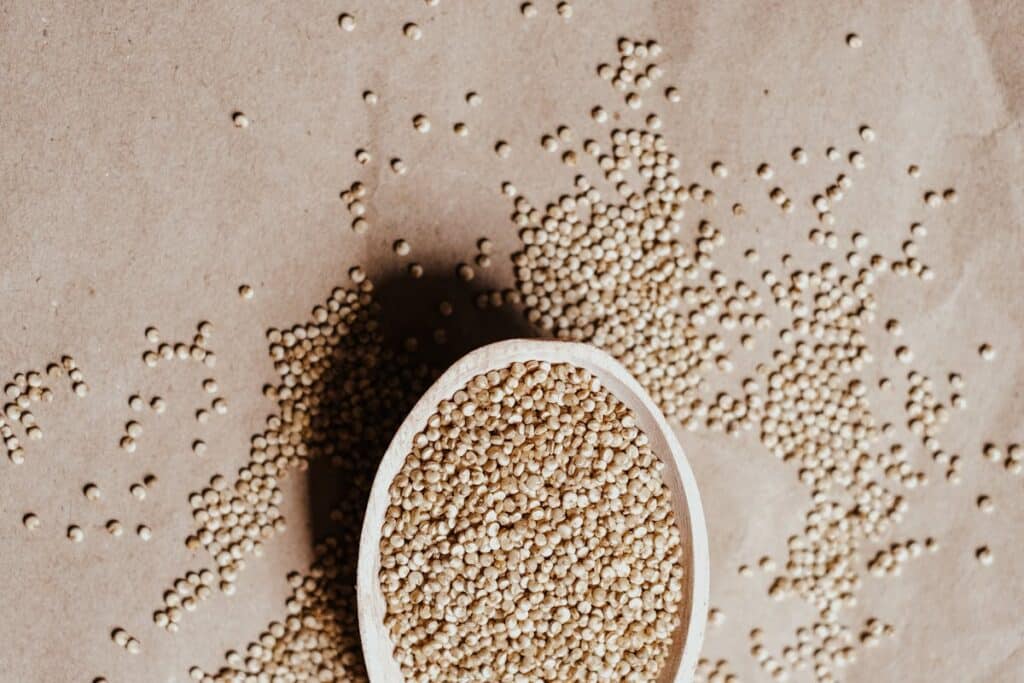
Quinoa stands out not only as a nutrient-dense superfood but also as an alkaline-forming grain, making it a valuable addition to an alkaline diet. Quinoa, along with other grains like amaranth and millet, is one of the few naturally alkalizing grains. This quality makes it an excellent choice for those looking to maintain a balanced pH level in their diet.
In this article
This protein-packed powerhouse is not just nutrient-rich but also maintains an alkaline pH balance, making it an excellent choice for adherents of an alkaline diet. In this article, we will break down the alkaline nature and what this means for your diet.
What is an alkaline diet?
An alkaline diet aims to lower your body’s acidity levels by consuming mainly alkaline-forming foods. These foods, in essence, help to neutralize the acid, leading to improved health benefits like better digestion, increased energy, and a boosted immune system.
An alkaline diet typically includes high consumption of fruits, vegetables, nuts, and legumes, while reducing intake of meat, dairy, refined sugar, and processed foods. These choices are thought to promote a more alkaline environment in the body.
What health benefits does an alkaline diet offer?
Beyond potentially reducing acidity in your bodily systems, an alkaline diet can offer numerous other health benefits. These include:
- improved kidney function
- a decreased risk of hypertension and stroke
- stronger bones and muscles
- overall enhanced health and wellbeing
What makes quinoa a good addition to an alkaline diet?
Quinoa, a gluten-free pseudocereal is naturally alkalizing. Although quinoa itself is slightly acidic, with a pH around 6.0 to 6.8, it is considered alkaline-forming in the body. This means that during digestion and metabolism, it produces more alkaline residues, which can help balance the body’s pH levels.
It’s versatile, easy to prepare, and can be incorporated into any meal, giving it a unique standing in an alkaline diet.

What are the health benefits of quinoa?
Quinoa is a nutrient-rich seed and offers numerous health benefits. These characteristics make it a beneficial addition not only to an alkaline diet but to any healthy eating plan
1. Nutrient-rich
Quinoa is a complete protein, providing all nine essential amino acids that our bodies can’t produce on its own. It’s also packed with vital vitamins and minerals like manganese, magnesium, phosphorus, folate, and copper.
2. High Protein Content
Protein is essential for muscle growth, repair, and general body functions. Known for its substantial protein levels, quinoa is an excellent source of plant-based protein, ideal for vegetarians and vegans.
3. High Fiber Content
With its rich dietary fiber content, quinoa supports digestive health. Fiber aids in regulating bowel movements, enhances feelings of fullness, and can play a role in weight management.
4. Gluten-Free
As a naturally gluten-free grain, quinoa is a great option for those with celiac disease or gluten intolerance.
5. Low Glycemic Index
Quinoa has a low glycemic index, meaning it minimally affects blood sugar levels, which is beneficial for people with diabetes or those managing their blood sugar. One study showed that increased quinoa consumption reduced the risk of developing diabetes among elderly individuals with prediabetes.
6. Rich in Antioxidants
Quinoa contains antioxidants like quercetin and kaempferol, which help combat free radicals in the body. These antioxidants are important for reducing inflammation and promoting overall health.
7. Heart Health
Quinoa’s mix of fiber, healthy fats, and nutrients such as magnesium may help improve heart health by lowering blood pressure and reducing the risk of cardiovascular diseases.
8. Bone Health
Rich in minerals like magnesium, phosphorus, and manganese, quinoa also supports strong and healthy bones.
9. Weight Management
The high protein and fiber content in quinoa can help increase satiety and fullness, potentially aiding in weight management by helping reduce calorie intake.
How can I incorporate quinoa into my alkaline diet?
Quinoa is a gluten-free option, ideal for those with celiac disease or gluten sensitivity. It”s available in various colors like white, red, and black, each offering a unique taste. White quinoa has a milder flavor compared to the nuttier red and black varieties, making it a good starting point for those unfamiliar with quinoa’s distinct taste.
Similar to other grains, quinoa needs to be cooked before consumption. To prepare, boil one part quinoa in two parts water, uncovered, for about 15 to 20 minutes until all the water is absorbed, resulting in fluffy and tender quinoa.
From salads to sides, there are other countless ways to add quinoa to your diet. Try these quinoa recipes for your next meal:
Frequently Asked Questions (FAQ)
Got more questions about this topic? Check out some commonly asked questions below:
What are the most alkaline grains?
The most alkaline grains include millet, buckwheat, and amaranth, in addition to quinoa. These grains are generally recommended in an alkaline diet due to their nutrient profiles and lower acidic effects.
Is quinoa flour acidic or alkaline?
Quinoa flour is considered alkaline. Like whole quinoa, quinoa flour is alkaline-forming in the body, supporting an alkaline diet by promoting a more balanced internal pH.
Bottomline
Quinoa’s alkaline nature and rich nutrient profile make it a superior choice for anyone seeking to maintain an optimal alkaline diet. Its versatility and delicious taste make it easy to incorporate into your daily meals, greasing the wheels for a healthier, more alkaline lifestyle.
